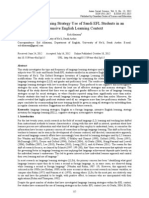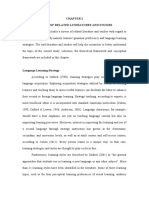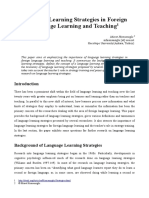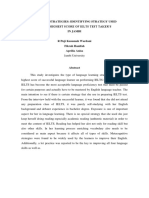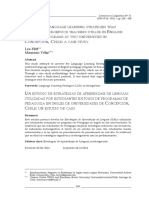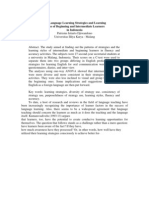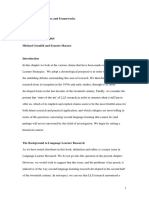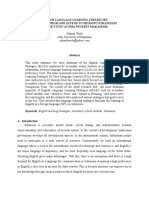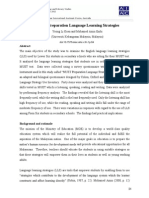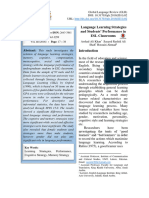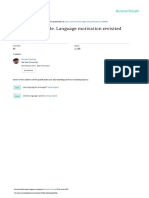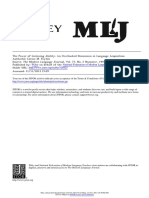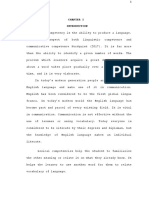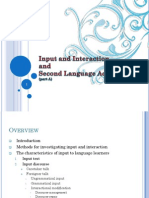Copyright © 2019 Sumarni & Rachmawaty
Ethical Lingua Ethical Lingua is licensed under CC-BY-NC-SA 4.0 License
Journal of Language Teaching and Literature
ISSN 2355-3448 (Print)
Issued by Program Studi Pendidikan Bahasa Inggris
ISSN 2540-9190 (Online)
Fakultas Keguruan & Ilmu Pendidikan, Universitas Cokroaminoto Palopo
Volume 6, Number 1, August 2018 Jalan Latammacelling 19, Palopo, Sulawesi Selatan, Indonesia 91913
pp. 13 – 22
Gender Differences in Language Learning Strategies
Sumarni *1 & Noor Rachmawaty 2
* ninimarni@gmail.com
1
Universitas 17 Agustus 1945 Samarinda, Indonesia
2
Universitas Mulawarman, Indonesia
Received : 13 February 2019; Accepted: 05 March 2019
URL : https://journal2.uncp.ac.id/index.php/ethicallingua/article/view/1169
DOI : https://doi.org/10.30605/ethicallingua.v6i1.1169
Abstract
This study investigates the application of language learning strategies by
different gender of university students. To do so, memory, cognitive,
compensation, metacognitive, affective, and social language learning
strategies were investigated. To collect data, the Strategy Inventory for
Language Learning (SILL; Oxford, 1990) was administered to male and
female student. They, then, were analyzed using descriptive statistics. The
findings of the study indicated that students used a wider range of learning
strategies and different from those often preferred by their gender. Both
female and male often use social strategies while the lowest frequency
strategy use both them were different. The results of this study can be useful
for language teachers instead of raising their awareness on reducing the
gap between the students' language learning strategies and their teaching
technique preferences.
Keywords: language learning strategy; gender; male; female
13
�Sumarni & Rachmawaty:
Gender Differences in Language Learning Strategies
Introduction
English as an international language has become the main requirement in
this world to be accepted in international level associations. Students are
required to be able to use English as accurately as possible in order to interact
with the world community. Because of this urgency, the learning of English has
been proclaimed by the government everywhere to every subject to be studied
as early as possible at any level of education. However, this appeal does not
necessarily make the people who learn it can be skilled in foreign languages.
Learning English, especially language as a foreign language for a long time, is
not a guarantee that they will be skilled in speaking at a higher level. Many
factors influence it and this then becomes interesting to be used as research
studies from year to year.
One interesting discussion examined from year to year is a discussion of the
relationship between the strategies of learning English in relation to the
achievement of learning outcomes or the relationship with student performance,
which can be influenced by other factors. This issue was developed in the era of
the 90s, whereas the beginning of this issue developed, a number of
researchers only described the dominant learning strategies used (Abraham &
Vann, 1987; Breen, 2001; Horwitz, 1987). Although refraining from categorizing
beliefs as ‘good’ or ‘bad,’ researcher stated that learners’ subscription to certain
beliefs had a direct consequence on the ways they learn (Riley, 1997). Recent
researches which have developed until now have not only illustrated the
dominance of the strategies used but are related to other factors. (Riazi &
Rahimi, 2005; Chamot, 2005; Aharony, 2006; Zhang, 2008; Yunus, 2016). One
factor that should not be ignored is about gender differences. There are many
results of research that give different results about the meaningful learning
strategy associated with gender, which is certainly a separate signal to find out
whether there are other factors that influence the differences in the results.
Gender differences in achievement of language learning achievements are
seen as learning strategies used is a study that has been studied by many
researchers. Some of them tried to find problems that existed in differences in
the learning outcomes of men and women viewed from various fields of science
and from various perspectives. The results of the study prove that the relevance
of gender with learning outcomes in a particular field is very meaningful where
the value of the success of male learners outperforms the value of female
students (Maharani et al, 2018;Tang et al, 2014),. However, some studies on
gender differences do not provide significant results for the linkages of this
problem.
14
� Ethical Lingua, Vol. 6, No. 1, February 2019
ISSN 2355-3448 (Print)
ISSN 2540-9190 (Online)
Definition of language learning strategies
Many researchers have defined the term language learning strategy. Oxford
(1990) defines language learning strategies as “approaches or techniques that
learners use to enhance their progress in developing L2 skills ". Wenden (1991)
defines it as "mental steps or operations that learners use to learn a new
language and to regulate their efforts to do so." Richards & Platt (1992) define it
as "intentional behavior and thoughts used by learners during learning so as to
better help them understand, learn, or remember new information". Cook (2001)
defines learning strategy as "a choice that learner makes while learning or using
the second language that affects learning". Finally, Griffiths (2007) defines
language learning strategies as activities consciously chosen by learners for the
purpose of regulating their own language learning. These definitions inform us
that learning strategies are essential in learning a language.
Classification of language learning strategies
Rubin (1981) identified three kinds of strategies, which contribute directly or
indirectly to language learning: learning strategies, communication strategies,
and social strategies. O'Malley et al (1985) divided LLS into three main
categories: metacognitive, cognitive, and socio-affective strategies. In Oxford
(1990) a distinction is made between direct and indirect strategies: Direct
strategies require mental processing of the target language. There are three
main groups of direct strategies: memory strategies, cognitive strategies and
compensation strategies. Each group processes the language differently and for
different purposes. Indirect strategies, on the other hand, support and manage
language learning often without involving the target language directly. There are
three groups of indirect strategies: metacognitive strategies, affective strategies
and social strategies. Oxford's classification has been selected for this study.
Studies on language learning strategies
Many researchers have studied language learning strategies and factors
related to choice and use of language learning strategies. Those studies
includes learners' level of language proficiency, motivation, learning style,
cultural backgrounds, gender, nationality and context of language learning since
in the middle of 19th century then grew until the 20 century (Chamot,
2005;Aharony, 2006; Zhang, 2008;Mahalingam, M & Yunus, M,M, 2016). Also,
the fact that high use of social strategies somehow contradicted with the findings
(Gerami, et al 2011; Salashour et al, 2012; Tang, et al, 2014; Maharani et al,
2018 that reported learners tended to use more rote learning and language rules
and less communicative strategies.
Several studies indicated some of the learning strategy preferences reported
by students in different cultural contexts. It was found that students reported a
preference for social strategies as well as a disinclination to use affective
15
�Sumarni & Rachmawaty:
Gender Differences in Language Learning Strategies
strategies (Chamot,2004). Riazi, A & Rahimi, M, (2005) investigated the use of
language learning strategies by post-secondary level Persian EFL learners. The
results of the study pointed to proficiency level and motivation as major
predictors of the use of language learning strategies. The difference between
learners’ use of the SILL’s six major strategy categories was found to be
significant. Some studies have also been done to explore the language learning
strategies used by successful language learners so that they can be trained to
less successful language learners as a part of English teaching syllabuses
(Oxford, 1995). Most researchers have agreed that more proficient learners
employ a wider range of strategies more efficiently than less proficient learners
(Oxford, 1995; Lan, 2005; Oxford, 1996; Oxford & Ehrman, 1995; Philips,
1991;Gan Z & Humphreys, G, 2004).
Research on language learning strategies has attracted much interest from
researchers but the focus of this research strategy on language learning has
changed from the domain of language teaching to language learning. As Corder
(1981) said that language learning is considered more dynamic, the process is
more original and students will be more active in gaining knowledge. Based on
research conducted by Chang (2011) learning strategies have received
increased attention from a number of researchers in the field of knowledge of
English as a foreign language in relation to how language is studied for
differences that are individual in nature. (Chang, 1999; Cohen, 1998). The
importance of research on the use of language learning strategies is reported by
a number of researchers and identified in the nature of which students are
effective and good in their learning activities (Ehrman, Leaver, & Oxford, 2003).
According to Chamot (2005), the application of research to learning
strategies has two objectives. First is to identify and compare the strategies used
by students. Second is research that aims to provide a form of instruction that
can help students who are less successful in learning languages better
understand and achieve language learning outcomes. O’Malley et al (1985)
consider strategies as a tool to be active and involve self-regulation capabilities
that are important in the development of more communicative foreign languages.
Until finally recent research has identified the main key individual differences that
influence the choice of language learning strategies they use (Chang, 2011;
Griffiths, 2003; Lan, 2005). Alhaysony (2017) in this study of language learning
strategies also found results. This research shows that instructors are advised to
introduce and motivate students as a whole about language learning strategies.
Recommendations for further research are directed at other things, among
others, differences in age, types of research methods, multiple approaches,
language skills, self-confidence, social and cultural backgrounds, and personal
motivational factors. Saragih and Kumara (2009) suggest that there is a
significant difference in language learning strategies with intrinsic motivation.
16
� Ethical Lingua, Vol. 6, No. 1, February 2019
ISSN 2355-3448 (Print)
ISSN 2540-9190 (Online)
Language learning strategies used by students with high, medium and low levels
of intrinsic motivation differ significantly.
Since language is socially mediated and context dependent, it would be
expected that learners' use of language learning strategies may vary with the
context. In Iran, for instance, for the past three decades, due to a variety of
social and political reasons, Iranian EFL learners have had little or no contact
with native speakers of English. The use of Internet and other media, such as
satellite TV, is neither widespread nor easily accessible to all language learners.
Moreover, language teaching during high school years is mostly grammar–
based with no attention paid to languages (Riazi, A & Rahimi, M, 2005). Thus,
this study intends to investigate the language learning strategies of Iranian EFL
university students by finding out what learning strategies they employ most
frequently. It also aims to compare the differences used in learning students
between the successful and the unsuccessful EFL students.
Starting from the discussion above, the authors are interested in
re-describing the study of gender differences in the choice of language learning
strategies used. The research questions of this study are: (1) what are the most
and least used categories of language learning strategies by gender difference?
(2) Are female and male high, medium or low 'language learning strategy' users?
Method
Participants
The participants attending this study were 12 male and female 12 learners
out of 50 subjects randomly selected from the students of FKTI Univerrsitas
Mulawarman Samarinda, majoring in TEFL.
Instruments
The study used two instruments, the Strategy Inventory of Language
Learning (SILL) by Oxford and self-teacher standard test. The current study
used SILL questionnaire (Oxford, 1990, pp. 293-300) to determine the type of
language learning strategies and frequency of strategy use of IT students. It is a
50-item Likert-type questionnaire with five-scale responses regarding the six
major strategy groups as distributed in Table 1. According to Oxford (1990)
classification, learners with the mean of 3.5 or more were considered as high
strategy users, learners with the mean of below 2.4 are low strategy users, and
the mean for medium strategy users is between 2.4 and 3.5.
Results
The overall use of language learning strategies
Table 1 shows in average over all female EFL students' responses to
language learning strategies. They used metacognitive, compensation, social,
17
�Sumarni & Rachmawaty:
Gender Differences in Language Learning Strategies
memory, cognitive, and affective strategies respectively. The mean of the most
frequently used strategy, social strategy, is 3.30. Moreover, the mean of the least
frequently used strategy, memory, is 2.62. The female EFL students reported
medium use of strategy categories, as the mean of overall strategy use is 2.88.
Tabel 1. Summary of strategy use showing female frequency used
Strategy Mean Rank Strategy use
Memory strategies 2.62 6 Medium; sometime used
Cognitive strategies 2.84 4 Medium; sometime used
Compensation strategies 2.93 3 Medium; sometime used
Meta-cognitive strategies 2.96 2 Medium; sometime used
Affective strategies 2.63 5 Medium; sometime used
Social strategies 3.30 1 Medium; sometime used
Table 2 shows in average over all male EFL students' responses to language
learning strategies. They used metacognitive, compensation, social, memory,
cognitive, and affective strategies respectively. The mean of the most frequently
used strategy, social strategy, is 3,22. And, the mean of the least frequently used
strategy, affective, is 2,72. The male EFL students reported medium use of
strategy categories, as the mean of overall strategy use is 3,01.
Tabel 2. Summary of strategy use showing male frequency used
Strategy Mean Rank Strategy use
Memory strategies 2,78 5 Medium; sometime used
Cognitive strategies 3,05 4 Medium; sometime used
Compensation strategies 3,15 3 Medium; sometime used
Meta-cognitive strategies 3,16 2 Medium; sometime used
Affective strategies 2,72 6 Medium; sometime used
Social strategies 3,22 1 Medium; sometime used
Use of strategies by gender
The overall use of language learning strategies by the subjects has been
shown in Table 1. This table presents the mean of strategy use among all the
subjects. The average strategy use for overall strategy use ranged from a high
3.2 to a low of 2.62, while the overall mean for the sample was 2.91. As for
strategy categories to both female and male students, social strategies were the
most frequently used strategies (M = 3.30 to the female and M = 3.22 to the male)
even though memory strategies were the least frequently used to female (M =
2.62) and affective strategy were the least frequently used to male (M = 2.72).
The descending order in medium frequency used were meta-cognitive strategy
(M = 2.96), compensation strategy (M = 2.93), cognitive strategy (M = 2.84) were
social strategies (M = 3.00) to female, while the descending order in medium
18
� Ethical Lingua, Vol. 6, No. 1, February 2019
ISSN 2355-3448 (Print)
ISSN 2540-9190 (Online)
frequency used were metacognitive strategy (M = 3.16), compensation strategy
(M = 3.15), cognitive strategy (M = 3.05) and memory strategy (M = 2.78) to male.
Discussion
As many result, in their interpretation cite that achievement is necessary to
students’ desire doing something more, with those of previous researches
(Maharani et al, 2018; Tang et al, 2014), which have indicated that the higher their
score the more frequencies student use many strategies in language learning
and can be identified too to gender differences.
Specifying in current results, dividing learners in male and female students’,
our project employed social strategies for both of genders (M = 3.22 for male, M =
3.30 for female) were the highest score where female students’ were upper than
male students’. This is similar to the findings of research (Bozinovic et al, 2011) in
Iran subjects. Also, despite the fact that high use of social strategies in this study
somehow contradicted with the findings (Gerami, et al 2011; Salashour et al.,
2012; Tang, et al., 2014; Yih, et al., 2017; Maharani et al, 2018) that they reported
learners tended to use more rote learning and language rules and less
communicative strategies. It is surprised us finding the newest of dominances
frequency of language learning strategies.
Another finding of this study is still focus to gender differences. One of the
lowest frequency of female students’ strategies was cognitive strategies. It is
similar to the finding of (Salashour et al, 2012; Bozinovic et al, 2011) promoted it
to their research. This means that cognitive strategies such as ‘dividing words
into smaller parts to understand, ’using words in different ways’, and making
summaries’ are not very common among Iranian high school second language
learners. It can be said that the need to change of mainstream curriculum is
emerge which normally do not focus to developing students’ cognitive strategies.
Surprisingly, affective were the lowest of frequency language learning
strategy use to the male students’ in this study. It is the same finding in students
of collage in Iran (Gerami et al., 2011) both successful and unsuccessful student.
It seems like they are not comfort to feel out of English such as writing feeling so
sad in diary, talking to someone about the failure or fill not something wrong in
any available mistaken during in classroom. This signs is likely to thinking it more
as another aspect to facilitate student more comfortable in class.
Conclusion
This study aimed to the use of language learning strategies among students
to promote a clearer understanding of the processes learners engage in the
process of learning a second language. It was revealed that all six language
learning strategies were employed at varying degrees of frequency by the
19
�Sumarni & Rachmawaty:
Gender Differences in Language Learning Strategies
subjects, and that this variation was subjects to learners’ gender.
Through this research, a number of information has been obtained. The
results of the study not only find a real picture of how learning strategies are used
by a number of students of different sexes but furthermore, clarifying how certain
indications can be found to know more about the characteristics of students and
how to clarify other language learning strategies introduced to them. Another
thing that can then become study material for decision makers about how the
best curriculum can be presented for more optimal learning outcomes.
This study has certain implications for second language pedagogy. For one
thing, what research of this sort may indicate is the necessity of raising
awareness among language learners of the functions and usefulness of such
strategies so that they become encouraged to select and use more appropriate
strategies at various stages of learning their second language. However, this
does not end in here. Awareness should also be built among language teachers
to recognize the salient role of leaning strategies for language learners, and to be
aware of the significance of factors such as gender and level of proficiency in the
learner choice of strategy use. Such awareness would undoubtedly help
language teachers in respecting individual differences among language learners
and thus may lead them towards implementing a learner-centered class. There
also exists an implication for syllabus designers and material developers in that
realization of the significance of learning strategies should be incorporated into
syllabi, textbooks, tasks and activities that not only requires the development of
learning strategies but also use such strategies.
References
Abraham, R.G. & Vann, R.J. (1987). Strategies of Two Language Learners: A Case
Study. In Learner Strategies in Language Learning. A. Wenden and J. Rubin
(Eds.), 85–105. London: Prentice Hall International.
Aharony (2006). The use of deep and surface learning strategies among students
learning English as a foreign language in an Internet environment. British Journal
of Educational Psychology 76, 851–866
Alhaysony. (2017). Language Learning Strategies Use by Saudi EFL Students: The
Effect of Duration of English Language Study and Gender. Department of English.
University of Hai'il Saudi Arabia
Anna & Chamot. (1991). A look at learner strategy use and ESL proficiency. CATESOL
Journal, 57-67
Breen, M.P (2001). Learner Contributions to Language Learning: New Directions in
Research. Harlow: Pearson Education Limited.
Božinovic, N. & Sindik, J. (2011). Gender Differences in The Use of Learning Strategies
in Adult Foreign Language Learners, Original scientific article UDK:
371.3:811]:316.62-055.1/2
20
� Ethical Lingua, Vol. 6, No. 1, February 2019
ISSN 2355-3448 (Print)
ISSN 2540-9190 (Online)
Chang, C. (1999). Self-Directed Target Language Learning in an Authentic target
language environment: The Taiwanese Experience. Unpublished PhD dissertation
of York, UK
Chang, C. (2011). Language Learning Strategy Profile of University Foreign Language
Majors in Taiwan. eJournal of Foreign Language Teaching, 8(2).
Chamot, A.U. (2005). Language learning strategy instruction: Current issues and
research. Annual Review of Applied Linguistics, 25, 112-30.
Cohen, A. (1998). Strategies in Learning and Using A Second Language. London:
Longman.
Corder, S. 1981. Error Analysis and Interlanguage. Oxford.UK
Cook, V. (2001). Second Language Learning and Language Teaching. London: Edward
Arnold.
Ehrman, M., Leaver, B,. Oxford. (2003). A Brief Overview of Individuals Differences in
Second Language Learning
Gan, Z., Humphreys, G., & Hamp-Lyons. (2004). Understanding successful and
unsuccessful EFL Students in Chinese universities. The Modern Language
Journal, 88, 229-44.
Geramia, M.H & Baighloub, S.M.G. (2011), Language Learning Strategies Used by
Successful and Unsuccessful Iranian EFL Students. International Conference on
Education and Educational Psychology (ICEEPSY).
Griffiths, C. (2003)a. Language Learning Strategy Use and Proficiency. Unpublished
PhD Dissertation. University of Auckland
Griffiths, C. (2003)b. Patterns of language learning Strategies Use. System, 31(3),
367-383
Griffiths, C. (2007). Language learning strategies: Student's and teacher's perceptions.
ELT Journal 61(2), 91-99.
Horwitz, E. K. (1987). Surveying Student Beliefs about Language Learning. In Learner
Strategies in Language Learning. A. Wenden & J. Rubin (Eds.), 119–129. London:
Prentice Hall International.
Horwitz, E.K. (1988). The Beliefs about Language Learning of Beginning University
Foreign Students. The Modern Language Journal, 72(3). 283–294.
doi:10.1111/j.1540-4781.1988. tb04190.x.
Lan, R. (2005). Language Learning Strategy Profiles of EFL Elementary School
Students in Taiwan. University of Maryland.
Maharani, S. (2018). An Investigation of Writing Strategies Used by the Students on the
Perspective Language Proficiency and Gender. International Journal of
Multicultural and Multireligious Understanding, 5(5), 185-190.
O’Malley, J.M., Chamot, A.U., Stewner-Manzanares, G., Russo, R.P. & Küpper, L.
(1985). Learning strategy applications with students of English as a second
language. TESOL Quarterly, 19, pp. 557–584.
Oxford, R. (1990). Language learning strategies: What every teacher should know.
Boston: Heinle & Heinle.
21
�Sumarni & Rachmawaty:
Gender Differences in Language Learning Strategies
Oxford, R. and Ehrman, M. (1995). Adults language learning strategies in an intensive
foreign language program in the United States. System, 23,. 359–386. Issues in
Language Learning Strategy Research and Teaching
Oxford, R. (1996)a. Language learning strategies around the world: Crosscultural
perspectives. Second Language Teaching & Curriculum Center, University of
Hawaii.
Oxford, R. L. (1996)b. Language learning strategies: what every teacher should know.
Cairo: Anglo Egyptian.
Riazi, A. & Rahimi, M. (2005). Iranian EFL learners’ pattern of language learning
strategy use. Journal of Asia TEFL, 2(1), pp. 103–129.
Riley, P. (1997). The Guru and the Conjurer: Aspects of Counseling for Self-access. In
Autonomy and Independence in Language Learning. P. Benson and P. Voller
(Eds.) 114–131. London: Longman.
Richards, J. & Platt, J. (1992). Longman dictionary of applied linguistics. London:
Longman Group Ltd.
Rubin, J. (1981). Study of cognitive processes in second language learning. Applied
Linguistics, 11, 117-131.
Salahshoura, F. (2012). The relationship between language learning strategy use,
language proficiency level and learner gender. Akdeniz Language Studies
Conference.
Saragih & Kumara. (2009). Penggunaan Strategi Belajar Bahasa Inggris Ditinjau dari
Motivasi Intrinsik dan Gaya Belajar. Psikobuana, 1(2).
Tang, M. & Tian, J. (2014). Associations between Chinese EFL graduate students’
beliefs and language learning strategies, Shaanxi Normal University, Xi’an, China
Wenden, A.L. (1991). Learner strategies for learner autonomy. New York: Prentice-Hall.
Yunus . (2016). Good Language Learner and Their Strategies: An Insight. International
Seminar on Generating Knowledge through Research. Malaysia.
http://dx.doi.org/10.21070/picecrs.v1i1.504 359
Zhang, L. J. (2008). Constructivist pedagogy in strategic reading instruction: Exploring
pathways to learner development in the English as a second language (ESL)
classrooms. Instructional Science: An International Journal of the Learning
Sciences, 36(2), 89–116.
22









